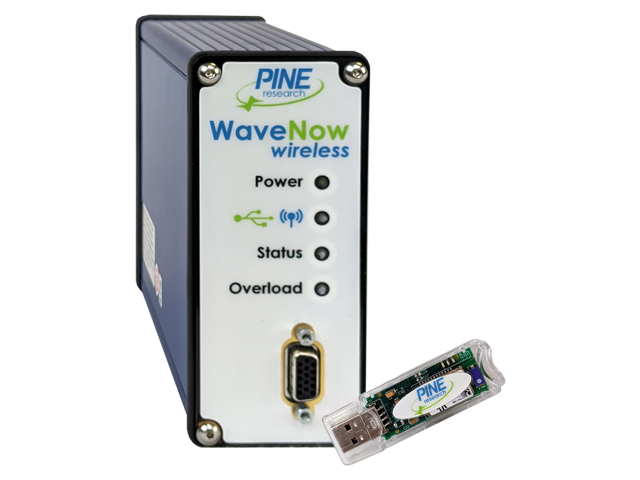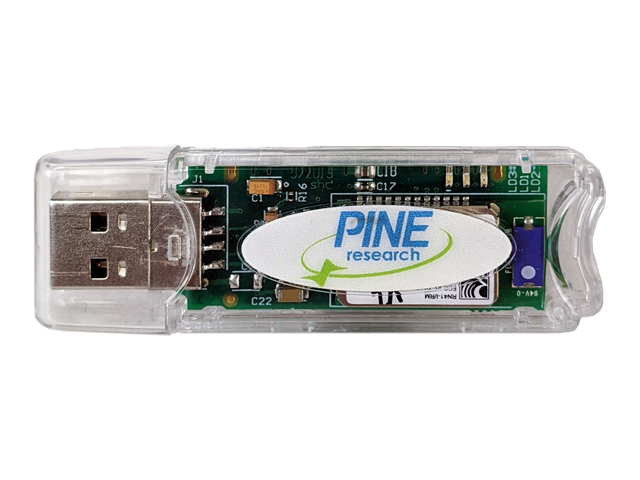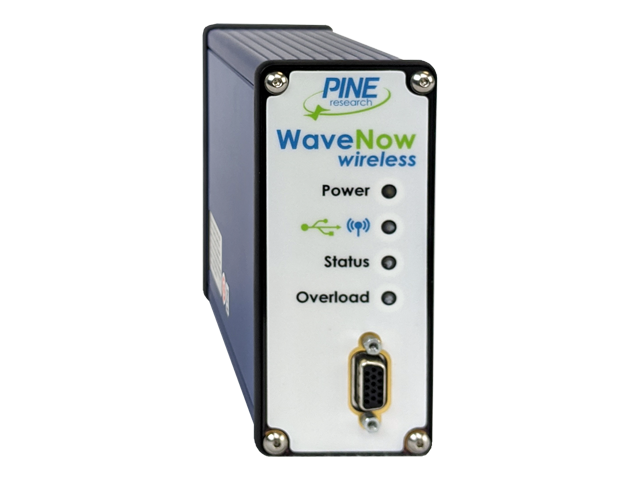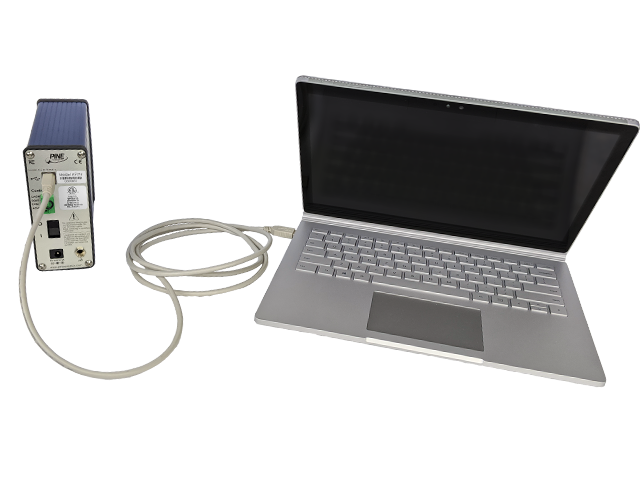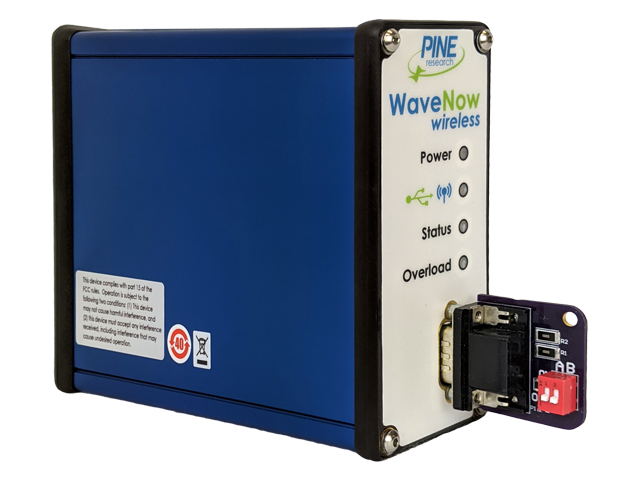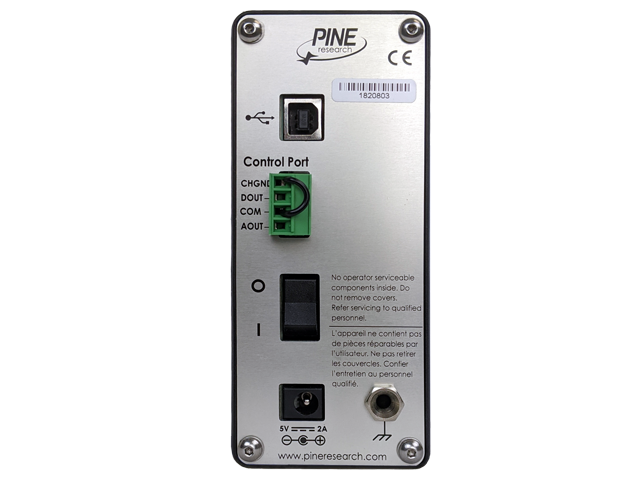[youtube https://www.youtube.com/watch?v=IvxJsLmIwdQ]
The WaveNow Wireless Potentiostat/Galvanostat is the latest development in our popular WaveNow® compact potentiostat series. How do you make something great even better? Reduce the wire clutter! For years, our customers have enjoyed using our small yet powerful WaveNow potentiostats for educational, research, and field-based applications. Now, the engineering team at Pine Research has stepped it up a level, adding wireless communication plus a few other new features. Imagine setting up your glovebox with an electrochemical experiment and not having to worry about passing cell cables or communications cables through the wall of the glovebox. The WaveNow Wireless makes this possible today.
This full-featured DC potentiostat includes six current ranges, a wide ± 8.0 V potential range, built-in iR compensation, an overload LED indicator, and an external port allowing it to control a rotating electrode or a spectrometer. Communication between the computer and the potentiostat can occur via a direct USB connection or via a wireless USB dongle. Power to the potentiostat can be supplied from a traditional AC power supply or from a rechargeable DC battery.
A license for our AfterMath® instrument control and data analysis software is included with every system. This single license gives you access to all of the DC electrochemical methods that the WaveNow Wireless can perform (Pine Research does not charge you extra for various categories of electrochemical techniques – will give all of them to you with a single license). Key features of our AfterMath software are listed below:
- Instrument Control. When started, AfterMath automatically detects all compatible instrumentation attached to the computer and provides complete control over each instrument. AfterMath can simultaneously and independently control multiple instruments, and multiple experiments may be queued on each individual instrument. Even as new experiments are queued or running in the background, data acquired in previous experiments may be manipulated by the user.
- Flexible Plotting. AfterMath has a powerful "drag-n-drop" feature that allows traces from one plot to be quickly and easily copied and moved to other plots. Preparing an overlay plot from several voltammograms is straightforward. AfterMath provides precise control over line sizes, point markers, colors, axis limits, axis labels, and tick marks. One or more text boxes may be placed anywhere on a plot, and the text may be formatted with any combination of fonts, font sizes, or colors as desired.
- Scientific Units. Unlike graphing software designed for business and marketing applications, AfterMath is designed with scientific data in mind. Proper management of scientific units, metric prefixes, scientific notation, and significant figures are built into Aftermath. For example, if an operation divides a potential measured in millivolts by a current measured in nanoamperes, then Aftermath properly provides the result as a resistance measured in megaohms.
- Data Archiving. A unique and open XML-based file format allows data from several related experiments to be stored together in one single archive file. Keeping related experiments together in an archive file eliminates the need to manage multiple individual data files on the hard drive. The internal archive hierarchy can contain as many subfolders, reports, plots, notes, experimental parameters, and data sets as desired (subject to available memory and storage).
- Tools and Transforms. Flexible tools can be placed on any graph to precisely measure quantities such as peak height and peak area. Multiple tools can be placed on a plot, and all such tools remain exactly where they are placed, even if the data archive is saved to a disk and reloaded at a later time. Fundamental mathematical operations (addition, multiplication, integration, logarithm, etc.) can be applied to any trace on any plot.
If you are already an owner of an earlier WaveNow model, you may be wondering how the WaveNow Wireless differs from earlier models. Our engineering team has packed the following new features into the WaveNow Wireless:
- iR Compensation. If you are working in a highly resistive solvent system, you can measure the uncompensated resistance between the working and reference electrodes (using a positive feedback iR drop measurement), and then the potentiostat can actively correct for this iR drop in subsequent voltammetry experiments.
- Overload Indicator Light. A red indicator light on the front panel signals an overload condition (i.e., signal exceeds measurement range).
- Wireless Communication. Communication is now possible without having to route a USB cable to the instrument.
- Expanded Current Ranges. Improved low current and high current limits with six ranges from ±5 nA to ±150 mA.
- Potentiostat Housing. The original WaveNow features a slick enclosure, but forces its use in one plane. Now, the (slightly larger) housing for the WaveNow Wireless permits either vertical or horizontal orientation for easier installation in tight spaces.
[call_to_action color="red" button_text="Pine Research YouTube " button_icon="youtube-play" button_url="https://www.youtube.com/channel/UCkaSux3EzBER0CU8P_9IOsw"] Visit our YouTube channel for helpful instructional videos regarding the use and maintenance of this and many other Pine Research products. [/call_to_action]

